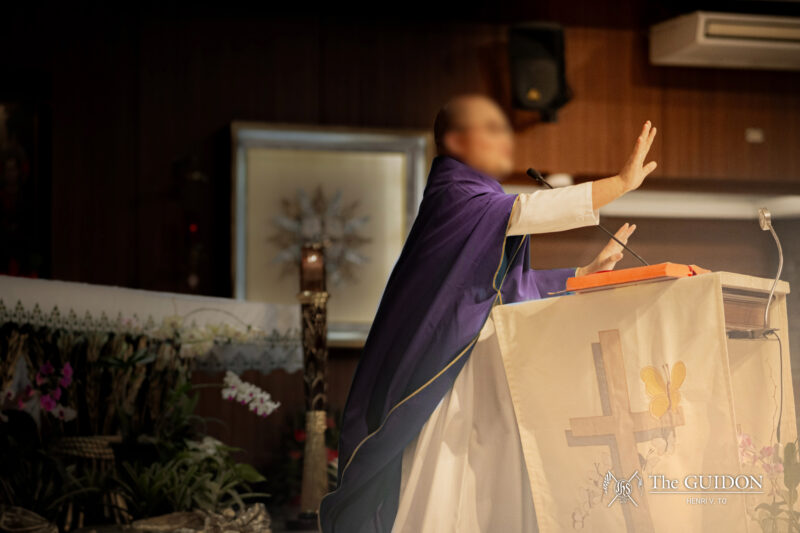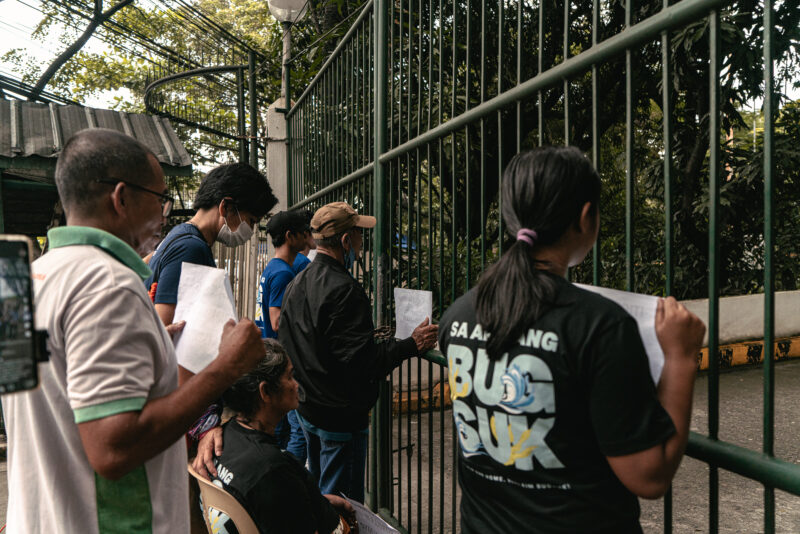For anyone traversing its wide avenues or narrow eskinitas, Manila hums a cacophonic symphony of traffic, trains and street vendors—except on Sunday. On Sunday, beneath the solemn Sabbath silence, Manila sings.
The chorus
The afternoon was surprisingly cool for the time of year. The orange sunlight from the southwest spilled over the low-rise buildings surrounding Plaza San Lorenzo Ruiz and into the plaza’s center. All I could hear when I caught sight of Binondo Church from Quintin Paredes Street was the sputtering putput of the trike I was riding in.
The church was founded in 1596 on a different site by the Dominicans primarily for the Chinese converts living in Binondo. After the abandonment of the church’s original location, Binondo Church was destroyed three times: By an earthquake in 1863, burned by the British by 1872 and bombed by the Americans in 1944. After World War II, it had no roof until it was rebuilt in the 1950s.
Today, Binondo Church is as extravagant as its other two names are verbose: The Minor Basilica of Saint Lorenzo Ruiz and Our Lady of the Most Holy Rosary Parish. The façade of the old granite church is a somber grey, but every cornice that runs along the entire exterior of the church is painted a deep red. On the facade, overlooking Plaza San Lorenzo Ruiz, is a golden sculpture of the plaza’s namesake. Fourteen huge murals depicting the Stations of the Cross are painted in the Renaissance style on the ceilings flanking the vaulted dome above the center aisle of the interior.
After the trike screeched to a halt, the plaza was still. To one side in the church’s vestibule, there was a stall selling various religious images, small sculptures and plastic bottles of holy water. The main gate, a towering set of steel bars, was locked but a side gate was open. Inside, the devoted were scattered among the pews, kneeling and saying prayers. A trio of tourists standing by the main gate took numerous selfies with the impressive apse and the many statues that adorn it in the background.
As I left, a raggedly dressed man opened the main gates in preparation for mass and the woman attending the stall offered me a bottle of holy water.
Disharmony
On the way to Quiapo Church, the trike driver dropped me off just before the corner of Gomez Street and Carriedo Street and told me to go straight down Carriedo until I reached the church. Turning off of Gomez, I found Carriedo to be a bustling marketplace lined with stalls selling everything from bootleg DVDs of Hollywood blockbusters to oranges carefully arranged into pyramids. Women wearing headscarves and smoking cigarettes shouted “Bili na!” as I passed by. It was a long, crowded walk through the street market, whose end was signaled by the ornate arch that hung over the entrance to Plaza Miranda.
The cream-colored church towered above the people standing solemnly around it. A Mass was being celebrated. Those who couldn’t find room inside were watching the celebration on a large screen set up outside the church.
The church that stands today is a far cry from the one that was first erected in 1586; in its first incarnation, Quiapo Church or Saint John the Baptist Parish was made only of bamboo and nipa. In the 428 years since then, it has been destroyed, redesigned and rebuilt five times. The Quiapo Church that stands today is a mixture of National Artist Juan Nakpil’s design from 1933 and the expansive renovations made in 1897 by Architect Jose Ma. Zaragoza. This expansion came at a cost; during the renovations, some of the remains of the Quiapo natives interred beneath the church were lost or discarded.
Looking at Quiapo Church from any side, it will always serve as an impressive background to the hundreds of makeshift vending stalls that surround it. Bottled holy water, religious imagery and religious folk charms—the “eyes of God,” which protects the wearer for accidents or the pampalakas for bravery and good fortune—are the goods displayed, but Plaza Miranda is the heart of a seedy commercial center where everything is available if one is willing to look beneath the tables. (The most notorious of these are the pamparegla or abortifacients.)
As I circled the church to get a better view of the façade, a child peddling religious amulets approached me, hounding me to buy one. In a bid to get away from the young vendor, I retreated into the church through the main door with the young boy hot on my heels; a voice from within the church spoke indistinctly over the public announcement system. Once past the vestibule, the incessant vendor relented, returning to the plaza. All around me, the churchgoers raised their hands and the opening lines to the Ama Namin (Our Father) filled the church completely.
I left after the prayer, and on my way to the jeepney stops along Quezon Boulevard, a man called me over and pointed out several pictures posted on a board on his stall. “Eto, ser, pampagana sa lalaki (Here, sir, aphrodisiacs for men),” he said pointing at the pictures of various herbal and chemical pills.
The soloist
The trike stopped right on the end of Plaza de Romana right across from Manila Cathedral. At the center of the plaza stood a statue on a pedestal in a fountain, flanked on every side by neatly trimmed hedges and carefully arranged stone pathways. Overlooking the plaza was Manila Cathedral or The Manila Metropolitan Cathedral-Basilica and its sharp gothic towers pointing to the heavens.
Manila Cathedral was intended to be the main church of Manila—as one could infer from its preferential location at the heart of Intramuros—when it was founded in 1571 by a secular priest named Fr. Juan de Vivero. And like nearly every old church in this city, Manila Cathedral was destroyed several times: It burned in 1583, was toppled by an earthquake in 1600 and completely leveled by Allied bombings in 1945. The repeated destruction and revival of the churches of Manila stands in line with the Christian tradition of resurrection.
The cathedral that stands today was constructed from 1954 to 1958 under the supervision of architect Fernando H. Ocampo. Today, Manila Cathedral still serves as the main church in the Philippines. In fact, during the recent papal visit, Pope Francis said Mass at the Manila Cathedral.
Crossing Plaza de Romana, I spied several formally dressed men and woman standing, chatting on the steps of the cathedral. A couple had just gotten married and the wedding party was having a photo shoot right at the cathedral’s altar.
Directly behind Manila Cathedral’s large wooden doors are another set of glass doors. Entering the air-conditioned cathedral provided instant relief from the heat of the mostly unshaded plaza outside. Manila Cathedral’s interior is soft and somber; it projects sophistication with its high vaulted ceilings, marble floors and intricate stained-glass windows without seeming excessively extravagant.
I could hear the wedding party shouting and laughing among themselves from the front of the cathedral. Other visitors were pacing along the perimeter of the cathedral, their heads mostly turned upwards examining the ceilings so far above them. On my way out, walking down the steps, I noticed a man sitting by an ice cream cart in the shade. The plaza was almost completely silent. He did not look at me.
A litany
The Reducciones was the Spanish urban planning policy of arranging towns around a central plaza and the church. The plan was that Manila would grow out with the church at its very heart. But today, Manila has grown into a labyrinthine cityscape and the churches that were once its heart have been swallowed up by the blistering heat, the crazed motorists and the seedy peddlers of illicit goods, leaving little comfort for troubled souls.







